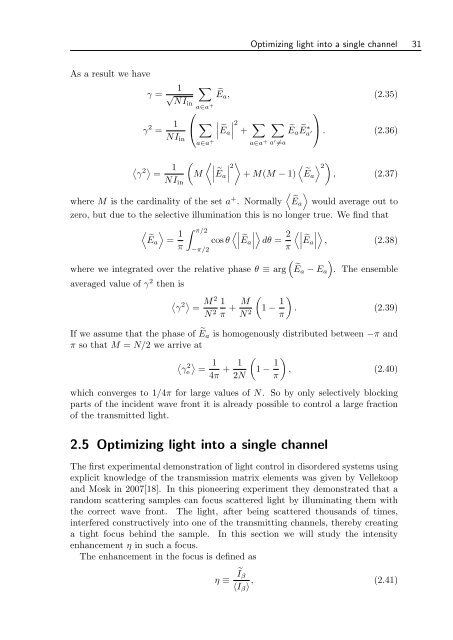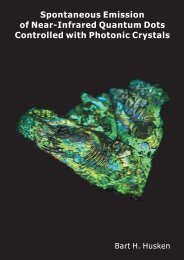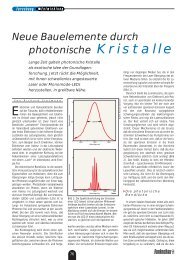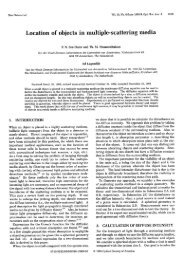Disorder-Enhanced Imaging with Spatially Controlled Light
Disorder-Enhanced Imaging with Spatially Controlled Light
Disorder-Enhanced Imaging with Spatially Controlled Light
Create successful ePaper yourself
Turn your PDF publications into a flip-book with our unique Google optimized e-Paper software.
Optimizing light into a single channel 31<br />
As a result we have<br />
γ =<br />
1<br />
√<br />
NIin<br />
∑<br />
γ 2 = 1<br />
NI in<br />
⎛<br />
⎝ ∑<br />
a∈a + Ẽ a , (2.35)<br />
∣ ∣ ∣∣ ∣∣<br />
2 ∑ ∑<br />
Ẽ a +<br />
a∈a + a∈a + a ′ ≠a<br />
Ẽ a Ẽ ∗ a ′ ⎞<br />
⎠ . (2.36)<br />
〈<br />
γ<br />
2 〉 = 1 ( 〈 ∣∣∣ ∣ 〉 ∣∣<br />
2 〉 ) 2<br />
M Ẽ a + M(M − 1)<br />
〈Ẽa , (2.37)<br />
NI in<br />
〉<br />
where M is the cardinality of the set a + . Normally<br />
〈Ẽa would average out to<br />
zero, but due to the selective illumination this is no longer true. We find that<br />
〉 〈Ẽa = 1 π<br />
∫ π/2<br />
−π/2<br />
where we integrated over the relative phase θ ≡ arg<br />
〈∣ ∣〉<br />
∣∣ ∣∣<br />
cos θ Ẽ a dθ = 2 〈∣ ∣〉<br />
∣∣ ∣∣ Ẽ a , (2.38)<br />
π<br />
) (Ẽa − E a . The ensemble<br />
averaged value of γ 2 then is<br />
〈<br />
γ<br />
2 〉 = M 2 1<br />
N 2 π + M (1<br />
N 2 − 1 )<br />
. (2.39)<br />
π<br />
If we assume that the phase of Ẽa is homogenously distributed between −π and<br />
π so that M = N/2 we arrive at<br />
〈 〉<br />
γ<br />
2 1<br />
e =<br />
4π + 1 (<br />
1 − 1 )<br />
, (2.40)<br />
2N π<br />
which converges to 1/4π for large values of N. So by only selectively blocking<br />
parts of the incident wave front it is already possible to control a large fraction<br />
of the transmitted light.<br />
2.5 Optimizing light into a single channel<br />
The first experimental demonstration of light control in disordered systems using<br />
explicit knowledge of the transmission matrix elements was given by Vellekoop<br />
and Mosk in 2007[18]. In this pioneering experiment they demonstrated that a<br />
random scattering samples can focus scattered light by illuminating them <strong>with</strong><br />
the correct wave front. The light, after being scattered thousands of times,<br />
interfered constructively into one of the transmitting channels, thereby creating<br />
a tight focus behind the sample. In this section we will study the intensity<br />
enhancement η in such a focus.<br />
The enhancement in the focus is defined as<br />
η ≡<br />
Ĩβ<br />
〈I β 〉 , (2.41)









